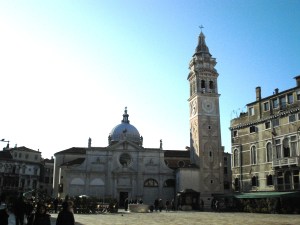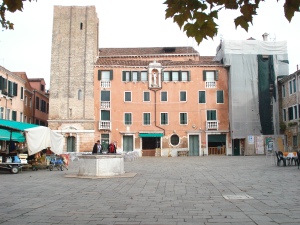No, not “Fawlty Towers”(c), the innovative and madcap work of some from the Monty Python(c) gang, but the fallen Campanili of Venice[no (c)]!
Constructing tall and skinny masonry towers on wooden pilings driven into lagoon sand or mud is a remarkable engineering achievement, particularly when we consider that the art goes back over 1000 years and many elderly members of the species campanili remain upright despite having reached ages numbered in many centuries!
A goodly number of these towers have not survived, due to the intentional interventions of man and those of natural phenomena including earthquakes, windstorms, lightening and fire. The “timber” stories are all dramatic, historical accidents, and some have taken with them not only homes or their churches, but human lives as well.
Symptoms, Cures and Losses
Leaning campanili do not only tweak the fancy of tourists, but seriously worry some of those who would be affected by a fall – whether financially, physically, historically or aesthetically impaired – when they have the time and inclination to worry about “leaners” and others in very poor physical condition. Some “leaners” have apparantly stabilized at an angle after moving slowly for centuries. In several cases, the tilt became apparant barely after completion of construction.
In the past, many campanili were replaced, renovated or redesigned – often taller – to repair damage or to fulfill a newer vision of church leadership. Finances allowing, such efforts may again be observed when earth subsidence, foundation or structural failure reach the “point of no return” – or worse, an earthquake, fire, windstorm or lightening – brings down another tower. Recent visitors to Venice have noticed the construction yards and “lookie-lou” obscuring fences surrounding the Campanile at San Marco and a few others, as foundation strengthening – a remarkable feat – continues over the years.
That type of work is widespread in the world. A firm associated with mine on design of a new building did complete design for now-successfully implemented work to totally replace the foundations for, and make seismically safe at the same time, the State Capitol of Tennessee in Nashville and the Salt Lake City/County Building in Utah – both gigantic structures – while occupancy and work continued inside them!
Some campanili fail in old age, falling over like a tree into the adjacent ria, crushing neighboring buildings beneath them, or occasionally settling with great gentility into a reasonably compact pile of bricks, stone and bells. In the early 20th Century, San Marco’s miraculously fell without loss of life into a giant pile of bricks and stone, crushing the Logetta beneath it.
For Whom the Bell Tolled
Here are a few examples, far in the past and far more recent, that illustrate these events. I am indebted to a number of sources I have accessed that were published from as early as the 1500’s to the present century (future book reviews!), personal observations, a student research project through the Venetian Studies Center of Worchester Polytechnic Institute (link: http://bit.ly/dGxIHH ), and Jim Cotten’s fabulous site, The Churches of Venice (link: http://bit.ly/g65OxA – a great achievement and ongoing endeavor!).
Collapses:
- Santa Maria delle Carita (Dorsoduro) – Not replaced.
- San Marco (San Marco) – Crashed twice, replaced twice!
- San Beneto (San Marco)
- San Stefano (San Marco) – Replaced by a leaner!
- San Silvestro (San Polo) – One of many earthquake losses
- Santa Maria Nova (Cannaregio)
- San Pietro in Castello (Castello) – Crashed twice, replaced twice, latest one leans
- San Zaccharia (Castello) – Partial crash, rebuilt
- San Pantalon (Dorsoduro) – Earthquake crash, rebuilt
- San Giorgio (Dorsoduro) – Crashed twice, replaced twice
- San Giorgio Maggiore (San Marco) -Crashed twice, replaced twice!
Leaners:
Leaners count in the American game of “horseshoes”, and leaning campanili are great cultural and physical assets to the City of Venice. Some campanili exhibit a range of “tilting” from slight to remarkable today, while over the millennium others eventually fell and were sometimes replaced.
The “leaning towers” are are great curiosity for visitors today.
Additional “leaners” most probably disappeared when, usually after suppression in the early 1800’s, the entire church complex was demolished. Others may have been simply unnoted in prose or paintings before their replacement occurred hundreds of years ago.
Here are a few examples of “leaners”:
- San Giorgio dei Greci (Castello) – Leaned from the beginning, at a remarkable angle!
- Santa Maria Formosa (Castello)
- Santa Maria Gloriosa dei Frari (San Polo) – Actually straightened long ago in a remarkable feat of engineering and construction.
- San Pietro in Castello (Castello) (previously collapsed twice!)
- San Stefano (San Marco) – The view from Campo San Stefano is stunning!
- Santa Maria del Carmini (Dorsoduro)
- San Martino (Burano) – Campanile acrobatics also occur in the outer islands!
Stumps:
Some campanili were shortened during a remodel, but whether for artistic or safety reasons is not always discernable in currently available reports.
Others were shortened after secularization in the Napoleonic era, cropped for pure safety reasons, or adapted for other uses when another campanile was built at a church. Some may be hidden within buildings visible today, awaiting discovery!
A few recorded examples, some no longer in existence, include:
- Santa Margherita (Dorsoduro) – After secularization, the ready to collapse tower was “shortened” and now lives another life – clearly visible in and from the Campo.
- San Marcuola (Cannaregio)
- Santa Sofia (Cannaregio)
- Sant’Agnese (Dorsoduro)
- San Tomo (San Polo)
- Sant’Eufemia (Giudecca)
- Santa Maria dei Giglio (San Marco)
- San Boldo (San Polo)
- Santa Ternita (Castello) – later demolition
- San Stin (San Polo)
“They Paved Paradise…”:
That fate overtook several campanili, including but not limited to:
- Santa Chiara (Santa Croce) – Piazzale Roma redevelopment.
- Sant’Anna (Santa Croce) – A fate as good as a parking lot…
Prudent and Predictable:
Many belltowers were removed as an interdiction prior to collapse, followed by construction of a replacement campanile. Other campanili were not completely rebuilt, but renovated to receive new or larger bells, to better fit the design of a new or remodeled church sanctuary, or simply to fit the designs of the church leadership!
Few of these remarkable towers have been untouched by man’s redesign or nature’s intervention during the long history of Venice. Viewing those that have been rebuilt, stunted, or are leaning might be a good reminder, regardless of one’s engineering prowess, that with brick as with other endeavors, quoting Immanuel Kant…
From the crooked timber of humanity, nothing exactly straight can be built.


